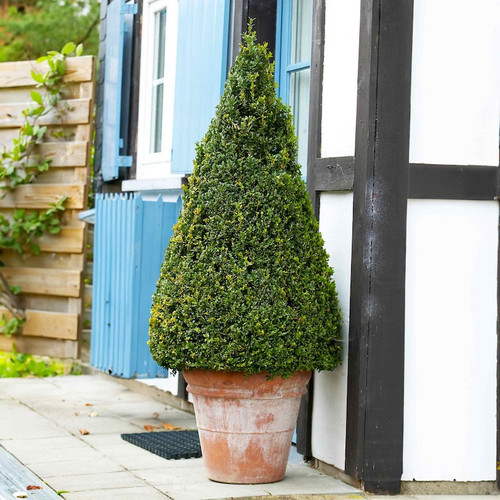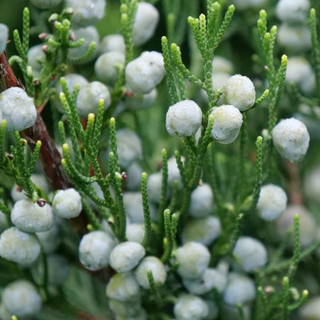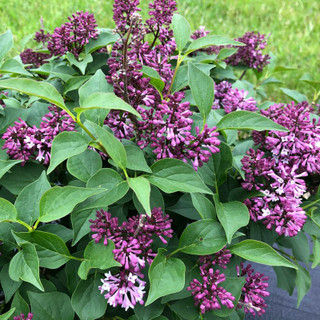
Boxwoods
Boxwood (buxus) are evergreen shrubs that are typically grown as hedges. The plants are easy to care for and can grow in areas that get at least 4 hours of sunlight.
Easy to care for
Perfect for hedges
Can be pruned into formal shapes
Adapts to most soil types
Growing zones 4 - 9
Related Boxwood Categories
About Boxwoods

Boxwood, Common Boxwood, European Box, Box
Europe, Asia, and Africa
Bushes
Evergreen
5-9
Yellow-Green
Late spring to early summer
Mounded, Upright, Compact
Bees
Heat, Drought
Deer, Rabbits
How To Use Boxwoods In The Garden
Boxwoods are known for their dense, evergreen foliage that stays neat and structured all year. With a slow growth rate and tolerance for frequent trimming, they are ideal for creating stylish topiaries, hedges, or formal garden designs. Most boxwood shrubs are very heat resistant and drought tolerant once established, making them ideal for challenging locations in full sun. They adapt to various soil conditions and climates and have a long lifespan.
Typically, gardeners and homeowners will plant boxwoods as a hedge to create a low growing border or fence. Their long, arching branches provide both height and texture, creating elegant layers in a mixed border or perennial bed. More experienced gardeners may prune these into unique shapes such as triangles, squares, and globes in formal gardens. Boxwoods can also be trained into a tree form. In garden planters, boxwoods provide four seasons of interest without much effort to care for the plants.
Types of Boxwoods
| Type | Scientific Name | Size (Approx.) | Habit | Zones | Uses | Features |
|---|---|---|---|---|---|---|
| Littleleaf Boxwood | Buxus microphylla (incl. var. japonica) | 3–4 ft tall (can spread 4–6 ft) | Slow-growing, often compact and rounded. Some forms can be looser or upright. | 5–9 | Ideal for low hedges and topiaries |
- Small, bright green leaves; some cultivars turn orange/bronze in cold weather - Good heat tolerance (popular in southern gardens) |
| Common/American Boxwood | Buxus sempervirens | 3–25 ft tall (depending on cultivar) | Highly variable: upright, conical, or spreading; dense foliage | 5–6 (to 8, cultivar-dependent) | Traditionally used in formal gardens and topiary |
- Over 400 cultivars; wide range of sizes and forms - Classic “boxwood smell” strongest in this species - Prone to leafminer, boxwood blight, moisture issues |
| Korean Boxwood | Buxus sinica var. insularis | 2–7 ft tall, up to 10 ft wide | Looser, more open habit than B. sempervirens; smaller leaves | 4–8 | Privacy screen, pathway edger, containers |
- Very cold-hardy - Foliage may discolor to red-brown in harsh winters - Less dense form improves air circulation and reduces disease risks |
| Hybrid Boxwood | Various crosses among the above | Varies widely (2–10+ ft) | Combines traits of parent species; forms range from upright to mounded | Typically 4–9 | Excellent for hedges, foundation plantings, topiaries |
- Bred for enhanced cold tolerance, pest/disease resistance, improved form - Leaf size and color vary by hybrid |
Boxwoods Care
Boxwood plants prefer well-drained soil with a slightly acidic to neutral pH. They grow best when planted in a location with partial to full sun, receiving at least four hours of sunlight daily. Consistent watering is key, especially during the first year, but avoid waterlogging the soil. Mulching helps retain moisture and regulate soil temperature. Fertilize in early spring with a balanced fertilizer to promote healthy growth.
Pruning boxwoods helps maintain their shape and encourages dense foliage. Trim in late winter or early spring before new growth appears, avoiding heavy pruning during the growing season. In colder climates, protect plants with burlap or mulch to prevent winter damage. Boxwoods also adapt well to container gardening, provided the pots can support the roots and have good drainage. Water container-grown boxwoods more frequently and consider insulating the pots during harsh winters to protect the roots.
Learn More About Boxwood Care
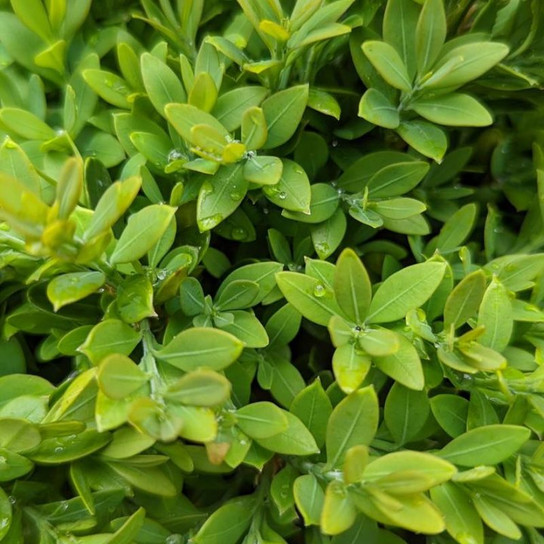
Planting Boxwoods Into Hedges
Boxwood is best planted in fall or spring, allowing the roots time to establish before harsh weather sets in. Select a spot that receives sun or partial shade, with soil that drains readily; if your soil is heavy, add compost to improve drainage. Dig a hole as deep as the root ball and twice as wide, then position the plant so the root ball is slightly above ground level. Topdress with a light layer of mulch without piling it against the trunk, and water thoroughly after planting.
To plant a hedge, begin by confirming each variety’s mature width, as spacing depends on its final size. Generally, cut the recommended mature width in half to achieve a dense hedge, placing each plant from center to center at that distance. For example, a Wintergreen boxwood that grows about four feet wide would sit two feet away from its neighbors. Measure and mark planting locations beforehand, then dig holes accordingly to ensure an even, orderly row.
Learn More About Boxwood Planting
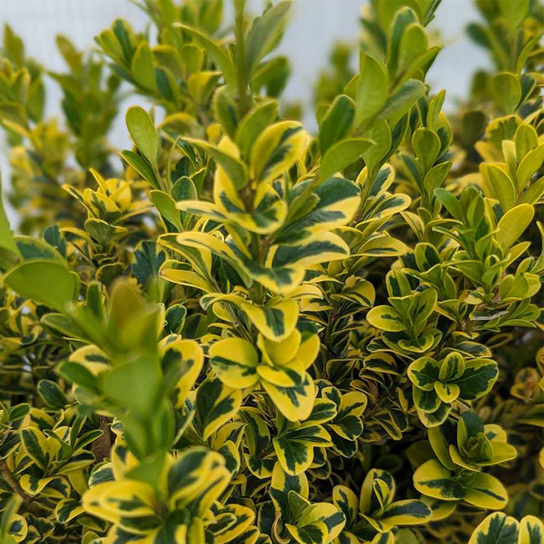
Boxwood Companion Plants
Companion plants must tolerate full sun, neutral, well‑drained soil, and moderate moisture levels, which keep boxwood dense and healthy. Lilac thrives in that same footing, adding fragrant spring panicles, while peony follows with bold early‑summer blooms that play neatly against the shrub’s tidy green dome. Shrub roses carry color through high summer, and Russian sage threads silvery stems and fine foliage between the manicured mounds, creating a layered display without crowding the boxwood roots.











